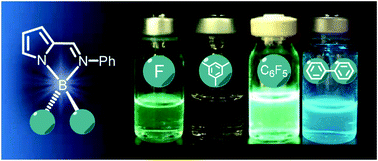New luminescent tetracoordinate boron complexes: an in-depth experimental and theoretical characterisation and their application in OLEDs†
Abstract
A group of new tetracoordinate mononuclear 2-(N-phenylformimino)pyrrolyl boron chelates [BX2{κ2N,N′-NC4H3-2-C(H)![[double bond, length as m-dash]](https://www.rsc.org/images/entities/char_e001.gif) N-C6H5}] (X = F 3; mesityl (2,4,6-trimethylphenyl, Mes) 4; C6F55; X2 = 1,1′-biphenyl-2,2′-diyl 6) and the related binuclear complex [(C6F5)2B{κ2N,N′-NC4H3-2-C(H)
N-C6H5}] (X = F 3; mesityl (2,4,6-trimethylphenyl, Mes) 4; C6F55; X2 = 1,1′-biphenyl-2,2′-diyl 6) and the related binuclear complex [(C6F5)2B{κ2N,N′-NC4H3-2-C(H)![[double bond, length as m-dash]](https://www.rsc.org/images/entities/char_e001.gif) N-C6H4-N
N-C6H4-N![[double bond, length as m-dash]](https://www.rsc.org/images/entities/char_e001.gif) C(H)-C4H3N-κ2N,N′}B(C6F5)2] 7 were synthesised via metathetic exchange reactions of sodium 2-(N-phenylformimino)pyrrolyl with BF3·Et2O (3), BMes2F (4) and 9-chloro-9-borafluorene (6), whereas 5 and 7 were obtained from the acid–base reactions between the corresponding neutral ligand precursors, respectively 2-(N-phenylformimino)pyrrole (1) and 1,4-(HNC4H3-C(H)
C(H)-C4H3N-κ2N,N′}B(C6F5)2] 7 were synthesised via metathetic exchange reactions of sodium 2-(N-phenylformimino)pyrrolyl with BF3·Et2O (3), BMes2F (4) and 9-chloro-9-borafluorene (6), whereas 5 and 7 were obtained from the acid–base reactions between the corresponding neutral ligand precursors, respectively 2-(N-phenylformimino)pyrrole (1) and 1,4-(HNC4H3-C(H)![[double bond, length as m-dash]](https://www.rsc.org/images/entities/char_e001.gif) N)2-C6H4 (2), with B(C6F5)2OEt. These complexes were designed to evaluate the influence of the boron co-ligands on the molecular properties of the corresponding 2-iminopyrrolyl tetrahedral boron derivatives, particularly on luminescence. Compounds 3–7 were photophysically characterised in solution and in solid state, exhibiting blue to yellowish-green emissions and fluorescence quantum yields (ϕf) up to 0.40. The exception was complex 4, which revealed full fluorescence quenching owing to a dynamic equilibrium involving the bidentate (tetracoordinate) 2-iminopyrrolyl boron complex and the corresponding monodentate (tricoordinate) species. DFT and TDDFT studies were carried out, considering the effect of solvent and also of dispersion forces, in order to elucidate the change in geometries of compounds 3–7 from the ground to the singlet excited state, to understand the dynamic equilibrium of 4, to ascribe electronic transitions, and to rationalise the observed luminescence and also the main trends of thermal stabilities. These complexes were applied in organic light-emitting diodes (OLEDs), the ones based on complex 6 showing the best performances (maximum luminance of 170 cd m−2 and electroluminescence efficiency of 0.037 cd A−1).
N)2-C6H4 (2), with B(C6F5)2OEt. These complexes were designed to evaluate the influence of the boron co-ligands on the molecular properties of the corresponding 2-iminopyrrolyl tetrahedral boron derivatives, particularly on luminescence. Compounds 3–7 were photophysically characterised in solution and in solid state, exhibiting blue to yellowish-green emissions and fluorescence quantum yields (ϕf) up to 0.40. The exception was complex 4, which revealed full fluorescence quenching owing to a dynamic equilibrium involving the bidentate (tetracoordinate) 2-iminopyrrolyl boron complex and the corresponding monodentate (tricoordinate) species. DFT and TDDFT studies were carried out, considering the effect of solvent and also of dispersion forces, in order to elucidate the change in geometries of compounds 3–7 from the ground to the singlet excited state, to understand the dynamic equilibrium of 4, to ascribe electronic transitions, and to rationalise the observed luminescence and also the main trends of thermal stabilities. These complexes were applied in organic light-emitting diodes (OLEDs), the ones based on complex 6 showing the best performances (maximum luminance of 170 cd m−2 and electroluminescence efficiency of 0.037 cd A−1).



 Please wait while we load your content...
Please wait while we load your content...